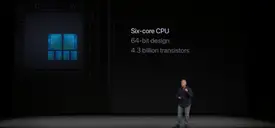| Edit Values | |
| A11 Bionic | |
| General Info | |
| Designer | Apple |
| Manufacturer | TSMC |
| Model Number | A11 Bionic |
| Market | Mobile, Embedded |
| Introduction | September 12, 2017 (announced) September 22, 2017 (launched) |
| General Specs | |
| Family | Ax |
| Frequency | 2390 MHz (Big) |
| Microarchitecture | |
| ISA | ARMv8.2-A (ARM) |
| Microarchitecture | Monsoon, Mistral |
| Core Name | Monsoon, Mistral |
| Process | 10 nm |
| Transistors | 4,300,000,000 |
| Technology | CMOS |
| Die | 87.66 mm² |
| Word Size | 64 bit |
| Cores | 6 |
| Threads | 6 |
| Multiprocessing | |
| Max SMP | 1-Way (Uniprocessor) |
| Succession | |
A11 Bionic is a 64-bit hexa-core ARM performance mobile system on a chip introduced by Apple in late 2017 as a successor to the A10.
Overview[edit]
Introduced during a keynote event on September 12 2017, the A11 Bionic features six 64-bit CPU cores. Fabricated on TSMC's 10 nm process, the A11 consists of two high-performance big cores which are said to be 25% faster than the A10 and four high-efficiency little cores said to be 70% faster than A10. In the A10 Apple had two pairs of cores - two little and two big, with little cores operating at half the frequency of their big cores counterparts. A11 doubles the number of little cores. It's worth pointing out that in the A10 at any given time only a single pair was active. In the A11, with the introduction of Apple's 2nd generation "performance controller", this restriction has been removed. The system can now use all six cores at once and is said to offer up to 70% performance improvement in multi-threaded workloads.
In prior models, Apple was using PowerVR GPUs designed by Imagination Technologies. The A11 is the first chip to make use of Apple's in-house designed GPU. The GPU is a tri-core design that is said to deliver 30% higher performance while using half the power as the A10. The GPU has been optimized for 3D visuals specifically for gaming apps and is optimized around Apple's Metal 2 hardware-accelerated graphics API.
The A11 also includes a new neural engine processor for accelerating image recognition, an ISP, and a Secure Enclave Processor (SEP).
ISP[edit]
The A11 incorporates Apple's image signal processor (ISP) for camera-related applications. The ISP is said to deliver faster autofocus in low-light scenarios and incorporates new pixel processing for sharpness and textures. The A11 ISP also incorporates new hardware for multiband compression/expansion noise reduction capabilities.
Integrated Graphics[edit]
The A11 incorporates an Apple-designed GPU. The GPU is a three-core design that is said to deliver 30% higher performance while using half the power as the A10. As with the previous microprocessor, the A11 incorporates a video encoder designed by Apple. Among other things, the encoder introduces two major features: faster video frame rates and real-time image analysis.
Apple stated that the encoder is now capable of real-time image and motion analysis. This is done by dividing the screen into individual tiles (on the iPhone 8 this works out to 2 million tiles) which are analyzed each second for things such as textures and edges to predict whether the tile is displaying things such as grass, water, sky or movement. Based on those properties the encoder can optimize the video encoding algorithms for quality and compression level.
The A11 supports faster video frame rates to improve slow-motion videos. The A11 supports up to 240 FPS at 1080p resolution which is double the previous frame rate.
Neural Engine[edit]
The A11 chip incorporates a new neural engine which implements a set of machine learning algorithms designed to accelerate image recognition. The engine, a dual-core design, capable of performing real-time processing at 600 billion operations per second. This is the second mobile processor on the market to feature such a processing unit after HiSilicon's Kirin 970.
Utilizing devices[edit]
- iPhone 8
- iPhone 8 Plus
- iPhone X
This list is incomplete; you can help by expanding it.
Bibliography[edit]
- Apple Keynote. (September 12, 2017). Apple Special Event.
- Daniel Yang, Stacy Wegner, Ray Fontaine. (September 10, 2017) "Apple iPhone 8 Plus Teardown". TechInsights.
| core count | 6 + |
| core name | Monsoon + and Mistral + |
| designer | Apple + |
| die area | 87.66 mm² (0.136 in², 0.877 cm², 87,660,000 µm²) + |
| family | Ax + |
| first announced | September 12, 2017 + |
| first launched | September 22, 2017 + |
| full page name | apple/ax/a11 + |
| instance of | microprocessor + |
| isa | ARMv8.2-A + |
| isa family | ARM + |
| ldate | September 22, 2017 + |
| manufacturer | TSMC + |
| market segment | Mobile + and Embedded + |
| max cpu count | 1 + |
| microarchitecture | Monsoon + and Mistral + |
| model number | A11 Bionic + |
| name | A11 Bionic + |
| process | 10 nm (0.01 μm, 1.0e-5 mm) + |
| smp max ways | 1 + |
| technology | CMOS + |
| thread count | 6 + |
| transistor count | 4,300,000,000 + |
| used by | iPhone 8 +, iPhone 8 Plus + and iPhone X + |
| word size | 64 bit (8 octets, 16 nibbles) + |
